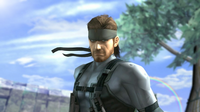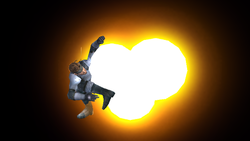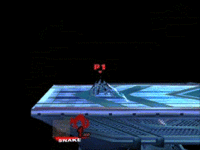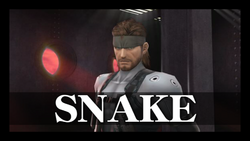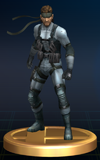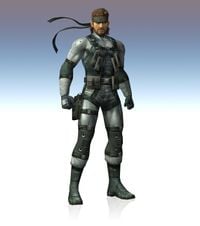Snake (SSBB)
| Snake in Super Smash Bros. Brawl | |
|---|---|
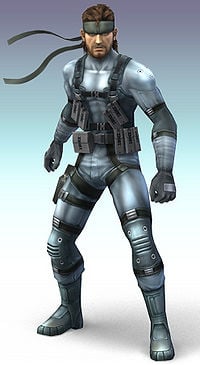 
| |
| Universe | Metal Gear |
| Availability | Unlockable |
| Final Smash | Grenade Launcher |
| Tier | A- (6) |
Unveiled at E3 2006, Snake (スネーク, Sunēku), known as Solid Snake in the character roll call and by other sources, is a character from the Metal Gear universe who appears in Super Smash Bros. Brawl. Instead of using a gun like he usually does in his games, he was designed instead to use explosive-type weapons and CQC (close quarters combat) from his own games.
Hideo Kojima, the creator of Metal Gear, was good friends with Masahiro Sakurai and wanted him to include Snake in Super Smash Bros. Melee, but since the game was in an advanced development stage and in an early launch in Japan, it was too late to include him as a character.[1] However, it was later announced at E3 2006 in one of the first teaser videos for Super Smash Bros. Brawl that Snake would be included in the game, making him the first official "guest" character in a Super Smash Bros. game.[2]
Snake currently ranks 6th on the tier list (the second-highest ranked unlockable character). One of Snake's strongest attributes is his ability to quickly deal damage and camp with his explosives; his Grenades come out on frame 1 and explode when attacked (providing him protection from some combos), deal 13% each and produce very large explosions, making them easy to be hit by, as well as high knockback, making them one of the best projectiles in the game. His Grenades, C4, and down smash mines provide excellent stage control and can make the stage very difficult for opponents to traverse without being damaged. Snake has fast and powerful neutral and tilt attacks, and his forward tilt, up tilt, down tilt, and neutral attack all have low startup and ending lag, good range, and deliver high damage and high knockback (in particular his up tilt), giving him a strong ground game. His disproportionately high weight, strong momentum cancelling abilities, and far-reaching recovery make him one of the most difficult characters to KO, especially vertically. Snake can also use his DACUS to approach easily and give him very fast movement speed across the ground (sliding a very large distance at a speed similar to Sonic's dashing speed). Almost all of his moves have high KO power, and he can set up tech-chases with his down throw that can deal lots of damage if he can read his opponent's actions. Snake is not without his flaws, however; his air game, due to his slow aerial attacks, fast falling speed, poor jumping height, and slow air speed, is among the worst in Brawl. Due to his poor mobility and air game, Snake is very vulnerable to being juggled (although using Grenades can remedy this to some degree), edgeguarded, and gimped; his Cypher recovery, while far-reaching, provides him very little protection from being edgeguarded. Because of his weight, he is also vulnerable to chain grabbing by characters such as Falco and King Dedede. Regardless of these flaws, Snake has strong matchups against most characters (being countered only by Pikachu and losing to only three other characters) and has been the second most successful character in tournaments after Meta Knight.
How to unlock
- Play 130 VS. matches.
- Play 15 VS. matches on Shadow Moses Island.
- Have Snake join the player's party in the Subspace Emissary (Battleship Halberd Interior)
With the exception of the third method, Snake must then be defeated on Shadow Moses Island.
Attributes
Despite not being as large as other heavyweights, Snake is a super heavyweight character; therefore, he has excellent momentum cancelling abilities, making him one of the most difficult characters to KO, especially vertically. In competitive play, it is not uncommon for skilled Snake players to survive until 200%. His high weight also allows him to trade blows with opponents at little risk of getting KO'd, particularly with his self-damaging explosives, as few characters can survive at KO percentages as high as he can.
Snake has one of the best ground games, with many attacks that are quick to come out and retain high KO potential. The third hit of his neutral is easy to connect, as it is the finisher of his neutral A combo. His jab is one of the best in the game, as it is fast with good reach. His forward tilt is arguably the best in the game, with very low start-up, great range, high knockback, and monstrously high damage. His up tilt is the best in the game, as it not only has all of the characteristics of his forward tilt, but it also has deceptively high horizontal reach that makes it Snake's most reliable finishing option. Snake’s dash attack shares the speed of his tilts, and unlike most dash attacks, can KO at realistic percentages. Snake has the lowest crawl in the game, which allows him to dodge many projectiles and some melee attacks. Snake's down throw is considered to be one of the best in the game, as it forces his opponent into a tech chase, keeping the opponent close to Snake and in range of his deadly ground game.
Snake is as deadly from afar as he is when close to his opponent, as he has the most projectiles in the game (practically, five, or seven when counting his Final Smash and taunt). His Hand Grenade is arguably his most versatile projectile, able to be used as a shield-dropped throwable item, a defensive option while shielding by damaging nearby opponents caught in the explosion, or a deterrence to opponents from approaching (unlike other throwable explosives, Grenades do not detonate on contact with enemy players). His up smash, the mortar, has the greatest vertical reach of any attack in the game. C4, the Remote Missile, and his down smash landmines act as great edgeguarders in conjunction with his forward aerial meteor smash and his back aerial.
Putting all of the above together leads to Snake's greatest strengths: his camping potential and defensive game, which are some of the best in the game. Since his projectiles can deter enemy approaches, they contribute to his already strong ground game. His up smash is known to have a great DACUS that lets Snake cover about half the length of Final Destination very quickly, compensating for his slow dash speed while at the same time releasing another explosive projectile onto the battlefield. His C4 has a variety of applications, aside from placing it on the stage itself as a defensive move, as it can be used in team battles to create a "suicide-bomber" (where the C4 is placed on a teammate like a Gooey Bomb), as well as being used on Snake himself to regain his recovery move, the Cypher. Nearly all of his projectiles can be used for edgeguarding.
On the downside, Snake suffers from severe mobility problems, particularly in the air. He has a high falling speed and high weight makes him extremely vulnerable to juggling and chain grabs, although his Hand Grenade, which comes out on frame 1, can ameliorate this. Although all of his aerials deal both high damage and knockback, they have long ending and landing lag, making them very punishable if missed. Being multi-hit attacks, his neutral and down aerials can be escaped by players with good SDI, which prevents him from getting the last hits on the attacks with strong knockback while also leaving him open for punishment. Snake also has the slowest ground jump in the game (10 frames). With the disadvantages of having a fast falling speed, very slow ground jump and long start-up, ending and landing lag in his aerial attacks, Snake has one of the worst aerial games (although his aerials themselves are stronger than his tilts) which makes him vulnerable to counter-picking on stages like Rainbow Cruise and Norfair where he is forced to attack in the air.
Snake also has difficulty recovering, especially from below the stage, as Cypher is very slow and predictable. The inability of the Cypher to deal damage to edgeguarding opponents leaves Snake vulnerable to meteor smashes when recovering. Snake's high falling speed also shortens his recovery potential. However, Snake can strategically damage himself with a C4 dropped in the air to allow him to use Cypher again, making his recovery nearly infinite. Also, grab releasing him (even with special grabs such as Wario's Chomp) after he's used his Cypher but before he's landed on the stage will make him lose his Cypher, which forces him to detonate C4 to attempt to recover again.
Moveset
Ground attacks
Normal
- Neutral attack - Punch, Punch, Spinkick. A natural combo. The final kick has high knockback, and KOs at high percentages, but can be powershielded depending on the character, even if the combo is done as fast as possible. This is the attack combo from Metal Gear Solid 2 and Metal Gear Solid games. 1st jab can also be canceled into a f-tilt or grab, and hits on frame 3. The farther hitbox of the 1st jab can also jab lock, easiest to set-up after knocking an opponent shielding an up tilt or full hop neutral aerial off a platform above Snake in stages like Battlefield. Does 14% if all three hit connect and is one of the only neutral attacks in the game capable of KOing before 150% (the other one being Ike's).
- Dash attack - Snake does a somersault forward, and ends up half-crouching at the end. Easily transitions to crouching/crawling. The somersault and subsequent transition to crouching are visually identical to those moves used by Snake in the Metal Gear Solid series. Can be cancelled to his up smash to make him slide a long distance, and it's much easier to cancel it if the attack connects and tap jump is off. Hits on frame 5. Does 6-11% depending on how it hits.
- Down tilt - Snake is fully prone while crouching, and he sweeps his legs around. While it is fast and has powerful vertical knockback, it is not as good as his forward and up tilt, due to having less reach and damage output than the f-tilt, and much less knockback than the up tilt. Also unlike his other two tilts, the down tilt doesn't have a disjointed hitbox. Hits on frame 6. Does 10% damage. It can be used as a surprise KO move since it's usually fresh when used.
- Up tilt - Snake kicks one leg up vertically. Arguably Snake's best kill move, as it has low start-up, great vertical reach, and surprisingly good horizontal reach, as well as great vertical knockback. Snake's up tilt is feared for its invisible disjointed hitbox that extends very far horizontally and slightly vertically (when spaced properly, it can out-prioritize Link's down aerial from above), giving it significantly more horizontal reach than it appears. Capable of KOing lightweights around 100%, middleweights around 115% while KOing heavyweights around 130% with proper DI when sweetspotted. Higher knockback when the hit connects earlier on in the attack, though the sourspot will still reliably KO under 150%. Is often considered on par with King Dedede's up tilt for being the best up tilt. Hit on frames 6-13. Does 13-14% and does 12% when sourspotted.
- Forward tilt - Does a knee-thrust forward and, if A is pressed again, an overhead swing of both arms. A natural combo. This move is seen during a cutscene in Metal Gear Solid: Twin Snakes when Snake fights Grey Fox. The first hitbox has extremely fast start-up (4 frames) and good horizontal reach. On grounded opponents, it is a very weak meteor smash with set knockback, causing hitstun but no knockback, which allows Snake to link the opponent into the second hitbox. On airborne opponents, the knee hitbox deals strong horizontal knockback, but it can be linked into the second hitbox at low percentages. Since the knee hitbox is a meteor smash on grounded opponents, it can cause tripping, which can set up an up tilt. The second hitbox has fast start-up as well as having great horizontal reach due its very large disjoint and strong horizontal knockback, with very little non-projectiles that outranges it. The f-tilt can be used for general damage racking, as a punishing move, for KOing, and it is also a useful out of shield option, as it takes only 11 frames for the hitbox to come out. Is considered to be the best f-tilt in the game due to its heavy damage output (highest damage output among f-tilts), extremely fast start-up and relatively little ending lag, great reach and high knockback. Can be Smash DI'd out of the knee hitbox to avoid the swing hitbox however. The knee hitbox does 8% and the overhead swing hitbox does 13% for a total of 21%.
Smash attacks
- Up smash - Snake slams a mortar (MGS4) in front of himself and fires a shell into the air. The movement of the shell is almost entirely vertical, but there is a varying small amount of random horizontal movement. The shell has high base knockback but very low knockback scaling, making it unreliable as a KO move, though its angles it hits at can sometimes make the opponent not sure where to DI for relatively early kills. Charging the up smash does not increase its power, but it increases the speed at which the shell is fired, making it go higher. When fully charged it travels great distances, almost the entire height of the 'large' stage builder area, making it have by far the greatest vertical reach of any attack. The shell explodes if it makes contact with a ceiling, an opponent, a wall or the ground no matter what direction it's moving in. The action of slamming down the mortar has a hitbox that produces very weak vertical knockback that knocks opponents into the mortar's line of fire. The shell cannot damage Snake unless it hits a Reflector. Snake's up smash is notable for its highly effective DACUS. Oddly enough, the shell does not break blocks in the SSE, but yanking the mortar out does. The shell hitbox does 10% while the mortar hitbox does 4%. Start-up of 11 frames.
- Down smash - Snake crouches and starts digging a hole in the ground as he charges, and sets a landmine. This is taken from Metal Gear and Metal Gear 2: Solid Snake. This down smash has very slow start-up (slowest down smash in the game, start-up lag wise, being about 55 frames) and does not actually deal any damage right away. A short while after planting the mine, it becomes active, and will detonate if anyone (including Snake) steps on it. If the platform the mine is set on disappears (such as on Rainbow Cruise or Delfino Plaza) the mine falls down and if it makes contact with anything, even the ground, it explodes. Players can't plant more than one mine at a time, but it can be moved by using the attack again, which removes it from its previous position and plants it at Snake's current position. After a while, or if Snake dies, the mine will blow up by itself. Does 14-19%.
- Forward smash - This attack is from Metal Gear Solid 3. Snake takes an RPG-7 rocket launcher and aims it at the ground directly in front of him, causing an explosion when released. It has very slow start-up and ending lag with a relatively large hitbox that has good horizontal and vertical reach. It has extremely high base knockback (the highest for any smash attack) but has only moderate knockback scaling. As a result, it can KO at very low percentages when on the edge (even below 25%), but its KO power is significantly lower when hitting an opponent that is far from a blast line. Overall, it is generally the third most powerful forward smash. Best used for punishing an opponent's laggy attack as it deals high shield stun if the opponent put up their shield in time. Can also be used to edge guard against predictable recoveries and be used after jab locking an opponent. When fully charged, it can KO at 33%. Hits on frames 41-43, ends on frame 79. Does 23-32%.
Other attacks
- Ledge attack- Picks himself up and swirls his leg forward. Does 8%.
- 100% ledge attack- Slowly gets up and kicks forward. Low range and easily shielded. Does 10%
- Floor attack- Rotates his body around with both his feet sticking out and gets up. Does 6%.
Aerial attacks
- Neutral aerial - Performs four kicks in quick succession. The first kick has fairly good start-up (10 frames), but the neutral aerial has a fairly long duration with high ending lag and landing lag, making it unwieldy and easily punishable. While it is difficult to land all four kicks on a grounded opponent, the fourth kick has very high horizontal knockback should it be landed. Best performed soon after a double jump, but all four kicks can come out in a full single jump. One of his moves that can prevent juggling if predicted well. Better against airborne and large characters, although it can be Smash DIed out of. Does 28% if all kicks connect, making it the most damaging neutral aerial in the game.
- Down aerial - Like his neutral aerial, except with four stomps below instead. With a start-up of 3 frames, all four stomps can be performed in a short hop. The last stomp has very high horizontal knockback. While very laggy and punishable, this attack is devastating against shields, and is a great punishing move if Snake can predict where an opponent may end up after his opponent performs a roll dodge. Can KO at medium-high percent. Unlike the neutral aerial, it is generally better against grounded opponents. Does 28% if all stomps connect, with the last stomp doing 13%. This attack is one of the strongest aerials in the game.
- Back aerial - Snake kicks his legs out behind him, making him plank in the air. Has fairly fast start-up along with good reach and very high horizontal knockback when sweetspotted. Has Sex Kick properties, meaning its hitbox has a long duration and is stronger at the beginning of the attack. The sweetspot is on Snake's chest region. While it has high ending lag like his other aerials, unlike his other aerials, Snake's back aerial never auto-cancels, so it is very punishable if it misses. The back aerial is useful for edgeguarding as well as countering juggles and KOing the opponent. This is Snake's aerial with the least total frames (42 frames). It is considered to be Snake's best and most versatile aerial, often seeing more use than his other aerials. Hits on frames 6-26. Normally does 14%, does 16% when sweetspotted, does 10% if the later hitbox is landed.
- Forward aerial - Snake lifts a leg to head height and axe-drops it down. Has slow start-up and high ending lag, but it is a very powerful meteor smash with great vertical and horizontal reach. Connection with the foot results in a very powerful meteor smash while connection with the leg results in very powerful vertical knockback that can star KO opponents over 100%. When the spacing for meteor smashing with the forward aerial is mastered, this is a surprisingly easy meteor smash to land. Notably, performing the attack slows Snake's descent by a little. Knockback wise, this is Snake's strongest aerial, and it is the strongest forward aerial meteor smash in Brawl. Hits on frame 23. Does 15%.
- Up aerial - Thrusts his legs straight upwards, similar to his back aerial except upwards. Fairly fast start-up with good vertical reach and powerful vertical knockback, but it has considerable ending lag. The up aerial is useful for star KOing airborne opponents that are above 100%. This is also Snake's aerial with the least landing lag (22 frames of landing lag instead of 30 like his other aerials). Hits on frame 10 and ends on frame 47. Does 14% if the initial hitbox is landed, does 10% if sourspotted.
Grabs and throws
- Grab - Holds his opponent in a restraining chokehold, which is a grabbing position unique to Snake. The pivot grab has great range, but his standing one grabs on frame 8 instead of the average frame 6. He can also both boost grab to increase his dash grab range and reverse boost grab to do a sliding pivot grab. Along with Yoshi, he is the only character in the game able to force jump breaks against all characters (when in a straight platform or a platform downwards angled).
- Pummel - Tightens his chokehold. Does 2%. Tied for being the fastest 2% pummel, but it's not very good at forcing ground breaks.
- Back throw - Throws opponent over his knee; The same type of throw is also seen in the MGS games. Can KO at high percentages if the opponent doesn't DI. Has stronger base knockback than his forward throw, but has similar knockback scaling. Does 9%.
- Up throw - Back suplex, similar to Jigglypuff's back throw. Can setup for his up tilt at low percentages. Does 10%.
- Down throw - Lays opponent on the floor, putting the opponent into the downed status. One of the best tech-chase moves in the game, and possibly the best throw in the game. Deals high damage when fresh, and enables a chain throw if Snake is able to predict where the opponent will recover. Does 12%.
- Forward throw - Flips them over and drops them (scoop slam). A strong throw, although slightly weaker than his back throw but like his back throw, it can KO at higher percentages if the opponent doesn't DI. Does 9%.
Special moves
Taunts
- All: Puts a cardboard box over himself, which is removable. Depending on the button pressed, Snake will get in the box in a different position. When he removes it, the enemy receives some damage (if they are in close range). The box can also be picked up and thrown by opponents. This deals 1-3% damage, making it the second damaging taunt in the Smash series after Luigi's down taunt. If an opponent is in the air and is hit by the box, it will gimp them.
- Smash Taunt: Kneels down and contacts his support team - Colonel Roy Campbell, Otacon, and Mei Ling, and also Slippy Toad (only when in a Brawl with Falco) - via his codec. Snake then receives information on one of his opponents; this goes for every fighter in the game, including himself, and with separate conversations for Sheik and Zero Suit Samus. This is possible only on Snake's home stage Shadow Moses Island, and is performed by down taunting extremely quickly. Snake will hold a pose for a few seconds, then a conversation between Snake and his support team will begin. This can only be done once each round and if the player is hit while Snake is holding his pose before the conversation starts, it is cancelled. However, the player can be hit while the conversation is going, though the conversation ends if Snake is KO'd, which, in a nod to the Metal Gear Solid game over screens, causes the character Snake was talking with to shout "SNAAAAAAAAKE!!". It can be done with any number of other players on the screen, but if there is more than one opponent, the game will randomly choose one character to talk about.
Idle poses
- Scratches his beard.
- Looks backward.
Cheer
Snake! Snake! Snaaaake! (a reference to the Metal Gear Solid game over screen)
In competitive play
Matchups
According to the current SWF matchup chart, Snake's matchup spread has the seventh highest unweighted rank and the eighth highest weighted rank. Snake's matchups are overall very positive. He is only countered by Pikachu, soft countered by Meta Knight, Olimar and King Dedede, and has even matchups with seven characters. He soft counters twelve characters, counters seven characters, and hard counters six characters. Snake's ability to camp and to have great stage control with his explosives are very effective along with his fast, powerful, and greatly ranged ground moves helps him have favorable matchups on most of the cast. Being a super heavyweight and having fast falling speed acceleration, he tends to be a target to characters who can chain grab fast fallers well such as Pikachu who can repeatedly use its down throw and forward throw on him and can finish with an Thunderspike and King Dedede who has an infinite chain throw on Snake with his down throw. With his recovery being predictable which makes him easy to edge guard and his slow and sluggish air game, characters with great air game and can gimp well such as Meta Knight has an advantage over him.
Notable players
- See also: Category:Snake professionals (SSBB)
Tier placement and history
Snake was ranked 2nd on the tier list shortly after Brawl's release, right below Meta Knight, although some believed that he was 1st instead; Snake was one of the most commonly used characters at tournaments, and it was not uncommon for the top-placing players to all use Snake. However, as Snake's vulnerability to juggling and gimpable recovery became exploited, and other character's powerful abilities were discovered, Snake has fallen to 6th place, although he is still in top tier and has been the second-most successful character in tournaments (after Meta Knight).
Other features
Wii Remote selection sound: Snake says "It's show time!"
On-screen appearance: Snake's appearance at the start of a Brawl comes from the intro cutscene in Metal Gear Solid 2. In MGS2, his stealth camouflage disengages after jumping from the George Washington Bridge and landing on the US oil carrier Discovery due to a malfunction from the landing impact. In Brawl, his stealth camouflage simply disengages to reveal himself to his opponent(s). Snake will sometimes say "Kept you waiting, huh?" when appearing.
Role in the The Subspace Emissary
Snake has stowed away somewhere on the Halberd, hiding inside a cardboard box. When his time comes, Snake emerges from his box and begins to investigate, but when he sees Lucario and Meta Knight, he hides again inside his box. Lucario sees through the box by looking at his aura, and pulls off Snake's disguise. Snake is surprised to see that he has been discovered (an exclamation point appears above his head along with the Metal Gear "Discovery" sound) and quickly assumes a fighting stance. Meta Knight is glad to oblige, when Lucario senses security Primids coming from the corridor behind him, so they end up forming a partnership with Snake. After battling through the onslaught of Primid, Snake and the others meet up with Zelda and Peach. Shadowbugs make clones of Peach and Zelda, which the trio fights. Later, Snake, Lucario and Meta Knight find the bridge of the ship and are surprised to see a group of Mr. Game & Watches are controlling the ship. Snake and Lucario throw all of the Mr. Game & Watches out of the window, and they all land on the front deck. The Mr. Game & Watches revert into Shadowbugs and combine into a giant metallic monster called Duon. Lucario, Snake, and Falco join Fox, Sheik, and Peach to battle and defeat the monster. Snake shows up with everyone else at the Entrance to Subspace and, like everyone else, he is turned into a trophy by Tabuu's off waves. He can be revived by collecting his trophy in Subspace, making him eligible for the final battle against Tabuu.
Snake is one of the few characters in the entire SSE storyline to have dialogue. When he reveals himself, he states to the player "Kept you waiting, huh?". This is a reference to the fact that he was seen earlier in the storyline in his box during the epilogue of The Forest. At the same time, it's also a direct reference to both Snake and Naked Snake's lines in the beginnings of Metal Gear Solid 2 and 3. Both games were eagerly anticipated by fans. Naked Snake's line also plays on the fact that MGS fans were excited to find that the main character of MGS3 was to be a Snake, after being disappointed with Raiden's appearance in the previous game.
Playable appearances
- 23. Battleship Halberd Interior
- 25. Battleship Halberd Bridge
- 28. Entrance to Subspace
- 31. The Great Maze - if he's rescued in Subspace (Part II)
Exclusive stickers
The following stickers can only be used by Snake:
- Eva: [Electric] Resistance +44
- Meryl Silverburgh: [Weapon] Attack + 7
- Naked Snake: [Specials: Indirect] Attack +32
- Solid Snake (Metal Gear Solid: The Twin Snakes): [Arm, Leg] Attack + 7
Costumes
Trophy
Snake's trophy is obtained by clearing Classic Mode with Snake.
Description
A former member of FOXHOUND with an IQ of 180 and mastery of six languages. He's an infiltration specialist whose ability to carry out missions under any conditions has made him a legend. He's saved the world three times from the threat of bipedal, nuclear-armed mechs called Metal Gear. Currently he's working with the anti-Metal Gear group known as Philanthropy.
Trivia
- Snake is the only character whose official art on Smash Bros. DOJO!! portrays him in a different pose from his original art from his old profile.
- Snake is the only character who talks when he eats food or other edible items. He often makes a "Nom" sound, but will sometimes say "Tasty!", and very rarely "Good!". However, when Wario eats his own bike or any other large item, he can be heard saying something like "Yom!". This is a reference to Metal Gear Solid 3, when the player eats food from their inventory, and the character reacts to the taste.
- Snake carries an H&K MK23 SOCOM .45 caliber pistol in a leg holster, but he never uses it in combat. Similarly, Captain Falcon carries a futuristic pistol, Sheik carries a dagger, and Ganondorf carries a broadsword, but none of them use these weapons in-game.
- Snake is the highest ranked heavyweight in the Smash Bros. series. Also unique to Snake's weight, he is the only "Super-Heavy" character who does not shake the screen when he lands.
- Snake has the most projectiles of any character in the game, with all four specials, his final smash, his up smash, and even his taunt.
- Snake's forward smash has the same amount of total frames as Ike's and King Dedede's forward smash. When compared to these two, Snake's forward smash is in the middle in both start-up and ending lag.
- Snake and Luigi are the only characters in Brawl who have a taunt that can damage an opponent.
- Pikachu, Zelda, and Snake are the only characters in the game where all three of their taunts temporarily make a held item disappear.
References
External links
- Solid Snake's page at Smash Bros. Dojo!!
- Snake Character Guide at SWF
- Snake's hitbox size of each of his moves
| Fighters in Super Smash Bros. Brawl | |
|---|---|
| Veterans | Bowser · Captain Falcon · Donkey Kong · Falco · Fox · Ganondorf · Ice Climbers · Jigglypuff · Kirby · Link · Luigi · Mario · Marth · Mr. Game & Watch · Ness · Peach · Pikachu · Samus · Yoshi · Zelda / Sheik |
| Newcomers | Diddy Kong · Ike · King Dedede · Lucario · Lucas · Meta Knight · Olimar · Pit · Pokémon Trainer (Charizard · Ivysaur · Squirtle) · R.O.B. · Snake · Sonic · Toon Link · Wario · Wolf · (Zero Suit Samus) |
|
| |
|---|---|
| Fighter | Snake (SSBB · SSBU) |
| Assist Trophy | Gray Fox |
| Stage | Shadow Moses Island |
| Item | Cardboard box |
| Other | Colonel Roy Campbell · Mei Ling · Otacon |
| Trophies, Stickers and Spirits | Trophies · Stickers · Spirits |
| Music | Brawl · Ultimate |
